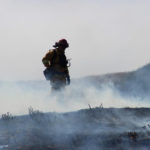
Has Smokey Bear’s message of forest fire prevention been taken too far? Photo credit: US Department of Agriculture via Flickr.
As a kid, I spent a lot of time in the woods. Every summer my parents would pack my four siblings and me into the back of our turquoise Ford Windstar and we’d set off for adventure in whatever western wilderness destination we’d chosen that year. Smokey Bear was always there to greet us as we entered state or national forests. We’d stare out the window with great concern at the benevolent, topless, wooden bear standing next to a sign indicating the day’s fire risk — in California it seemed like it was always high.
“Mom,” we’d yell, urgency creeping into our voices. “Moooom! Only WE can prevent forest fires!”
For us the message was clear and simple: forest fires are bad and they hurt the precious wilderness we had learned to love so much.
But I’ve come to rethink my straightforward anti-fire mentality after reporting a story about wildfire management for Mongabay.com in November. What I learned while working on the story has made me acutely aware that the question of how to best deal with forest fires is actually incredibly complex, both for my beloved west coast forests and to California communities.
The ecologists I spoke to for the article reminded me that fires are a natural part of most forest ecosystems — especially the dry forests of California. They told me that historically fires would burn in California all the time. The fires would sweep through a forest, eating up fuels, pruning back weak or dead trees, and leaving things scorched in their wake. But then, over the next few years, the forests would come back — in many ways stronger and healthier than before. Maybe most importantly they were less susceptible to future fires, because there was just less to burn. It was a way for fires to limit their own destruction.
“Fire is one of the most effective ways you can reduce fuel loading in the forest,” says Malcolm North a professor at the University of California, Davis and U.S. Forest Service research ecologist. If we keep pushing fire down the road until the worst conditions when we can’t control them, it drives fire in these landscapes towards only being severe fires, he says.
So, my sources argued, Smokey was wrong — or at least greatly oversimplifying things, as bears will do. We don’t need to prevent all the forest fires. We should let many of them burn themselves out, particularly the ones that occur in remote areas far from communities, they argue. When we don’t, we pave the ways for mega-fires like the Butte Fire in 2015 which destroyed over 800 structures including 475 homes in Amador and Calaveras counties in California.
But generally this is not what we tend to do. North shared a schematic with me showing that, in 2015, 51 percent of fires ignited in California were within remote areas. But “regardless of location or threat, all fires were extinguished at a cost of $101 million and 11 firefighter fatalities.”
In addition to budgetary issues, the main reasons I keep hearing for this practice are risk aversion and concerns about liability. Greg Aplet, senior science director of the Wilderness Society, says that if done right, we should theoretically be able to work with fires while still avoiding harm to communities and even isolated homes. The plans that he and his colleagues advocate for would involve zoning that would keep burns miles away from communities, and preparation around forest homes can protect them.
Still, no matter how low, there will always be a risk that fires could get out of control, damaging property or hurting someone.
“Right now with the way society works and with people being so risk averse, there’s such pressure on the commanders of the fire teams to put out the fire rather than work with the fire,” says Christopher Topik, a director at The Nature Conservancy.
And that makes sense. Who really wants to be the one who made that call if something goes wrong?
So as a citizen, I realized, I have to be one of the people accepting responsibility for those calls. If I want to improve long term safety and long term health of forests, maybe I need to stand behind the forest and fire officials in starting controlled burns and electing not to suppress fires. Maybe, we Californians need to give our blessing to burn during low risk conditions, when winds are low and the heat is down, so that we don’t push our forests to their limit —forcing wildfires to happen only in the absolute worst of circumstances, when we can’t mitigate the damage.
Right now Topik says that national forests across the country are working to revise their land management plans, “a really important opportunity for the public to make a change” by making their preferences known. As a member of California’s public, it makes me think it might be time to really start to question what kinds of risk I’m comfortable with when it comes to wildfires, and to participate in conversation about how forest fire management should proceed in the regions surrounding forests and communities dear to me.
It reminds me of an ethical question, called the trolley problem, which was discussed in my college psychology classes. The trolley problem requires a “moral” choice to be made. A train is racing down the tracks ready to smash into throngs of people. You are standing at the switch and have the power to divert the train so that it will instead hit a solitary individual on another track. What do you do?
I’d always walk away refusing to answer that question. Nobody enjoys uncomfortable hypotheticals. But as Californians, we can’t walk away. By doing nothing, aren’t we making a choice?







Comments are closed.